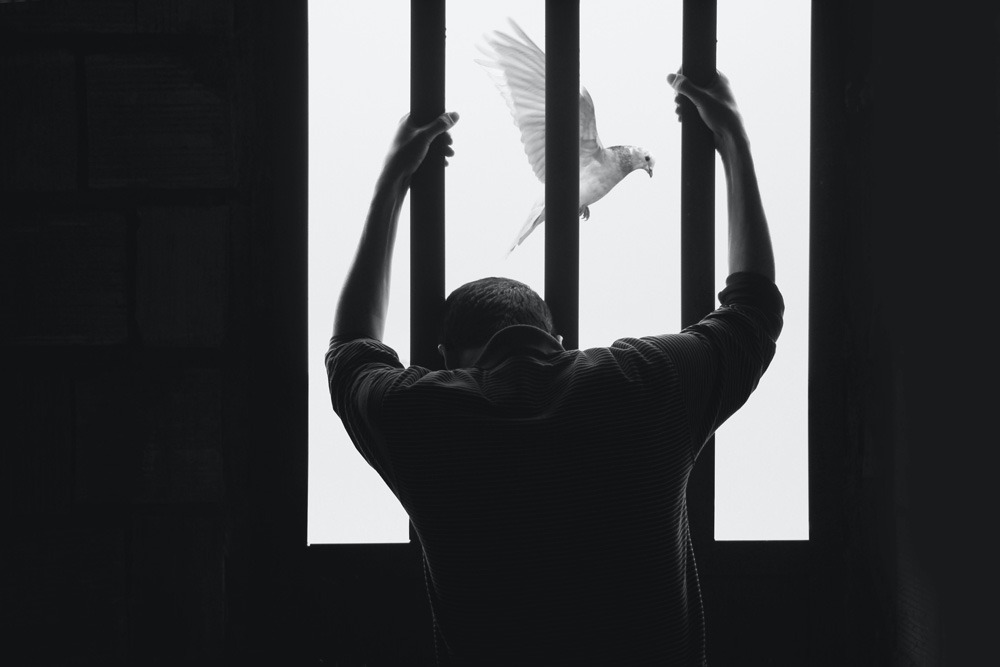
When the New York State Board of Parole finally let Mark Shervington out of prison, more than a decade overdue, one of the first things the 50-year-old did was visit a hospital. “I didn’t have any rap video fantasies about what coming home would be like,” Shervington told me. “My plan was simple: I was going straight to a doctor. I’d seen too many people get old and sick and die in there.”
He had good reason to be worried. Due to the unique stress that long-term confinement places on the body and mind, incarcerated people experience a process of accelerated aging, or “weathering,” which leaves them intensely vulnerable to the early onset of fatal health conditions. More to the point, Shervington knew something wasn’t right inside his chest. In the months preceding his release, preparing for his tenth and final appointment with the Parole Board, he experienced two successive heart attacks. He endured the excruciating pain “alone in my cubicle,” he said, unsure of what was happening. The prison doctor failed to even provide him with aspirin.
Twenty-eight years earlier, a judge in Queens had sentenced Shervington to 15 years to life in prison. This was the minimum sentence allowed for people convicted of second-degree murder in New York, but it was also an indeterminate one; after 15 years, Shervington’s release was entirely at the discretion of the Parole Board. The 15-year mark came and went, and every few years Shervington appeared before unelected parole commissioners who refused to consider his record of education and leadership behind bars. Instead, they repeatedly denied him parole based on the one thing he could not change—the nature of his crime.
“No one ever objected to me getting the minimum sentence except the Parole Board,” Shervington told me. When they finally released him in 2015, it was only because Shervington, by then an accomplished jailhouse lawyer, won a judgment against them in New York’s supreme court, which mandated a new, more balanced review of his parole application. It was after that judgment, in the high-pressure weeks leading up to his final parole hearing, that he suffered his life-threatening heart attacks.
Months later, while Shervington was undergoing his first medical examination as a free man in almost three decades, the doctors discovered a broken valve in his heart and immediately referred him for surgery. “I was walking around bleeding to death on the inside,” he told me. “Had I not been released, I would be a statistic. I’d be on someone’s t-shirt or poster right now.”
“What it boils down to is the Parole Board almost killed me,” he added. “I’m still fired up about that, and I think I’m going to stay that way.”
Parole reform advocates generally trace the origins of today’s dysfunctional parole system to Bill Clinton’s notorious 1994 Crime Bill, which set aside large reserves of federal funding to ease the fiscal burden of mass incarceration at the state level. In New York, this era coincided with the reign of the tough-on-crime governor George Pataki, whose uncompromisingly punitive vision motivated his appointment of parole commissioners. Before Pataki took office, the Parole Board granted release to about two-thirds of parole applicants; by the end of Pataki’s first term, that number had fallen by twenty percentage points. For people convicted of violent crimes, the change was even starker—their parole rates fell from 24 percent in 1991 to only 8 percent in 1998.
Today, parole is granted at roughly the same rate as during the Pataki era—about 40 percent. It is clear that Pataki’s punishment mentality, while increasingly anachronistic in other areas of New York state government, still prevails on the Parole Board. “We’re still living with the remnants of draconian sentencing laws from the 1980s and 1990s,” said Jullian Harris-Calvin of the Vera Institute of Justice, which in 2020 found that as many as 90 percent of parole denials are motivated by the commissioners’ opinion of the original crime, rather than any consideration of the applicants’ rehabilitation while in prison.
For some advocates, New York’s punitive parole practices present an opportunity to organize for the reunification of thousands of families—and, in that way, to challenge mass incarceration at its roots. Since at least the early 2010s, a vocal and remarkably tenacious cohort of incarcerated people, formerly incarcerated people, and their family members have built a coalition of parole justice advocates that today spans all corners of New York state. “All of our work is about building a movement. It’s about organizing masses of people,” said Laura Whitehorn, who co-founded the organization Release Aging People In Prison (RAPP) in 2013 with Mujahid Farid and Kathy Boudin.
RAPP, where Mark Shervington is now Statewide Advocacy Associate, has spent years fighting for a fairer parole process in New York. Together with coalition partners like the Parole Preparation Project, the organization has achieved some significant victories, including the confirmation of several parole commissioners from non-law enforcement backgrounds and some limited changes to the Parole Board’s internal regulations. But now, the statewide People’s Coalition for Parole Justice, of which RAPP is a key member, may be on the cusp of its most significant triumph to date.
Two bills that could transform New York’s parole system are currently making their way through the state legislature. The Elder Parole Act (S.15A/A.8855A) would render any prisoner over the age of 55 who has served at least 15 years of their sentence eligible for parole. Meanwhile, the Fair and Timely Parole Act (S.7514/A.4231) would change the standard for supervised release by compelling the Parole Board to evaluate applicants based on their current merits, not the nature of their crimes. Together, the bills could rescue hundreds, even thousands, of incarcerated elders from the tragic and completely avoidable fate of dying behind bars.
“We are allowing people to die in prison, and they haven’t even been given a death sentence,” said assembly-member Martiza Davila, a lead sponsor of the Elder Parole Act, at a recent press conference. “All we are asking is for them to have an opportunity to go before the Parole Board.”
“I refuse to let the elderly, vulnerable, and those eligible for parole continue to languish in prison, separated from their families,” added assembly-member David Weprin, a lead sponsor of the Fair and Timely Parole Act. “This is the year we are going to pass these bills.”
***
Earlier this year, New York State Comptroller Thomas P. DiNapoi issued a startling report: while the state’s prison population declined by half between 2008 and 2021, the proportion of incarcerated people over the age of 50 doubled. Today, nearly one quarter of the 31,262 people incarcerated in New York are over 50. Without political intervention, that proportion will keep growing as the prison population continues to age over the coming years and decades. Twenty-two percent of people incarcerated in New York are serving sentences of 10 years or longer, according to data from the Vera Institute.
Serving 39 years in Bedford Hills Correctional Facility for Women between 1979 and 2018, Roslyn Smith witnessed the profound aging of New York’s prison population. “I had youth when I came in,” Smith told me, “and I was middle aged when I came out, with gray hair and creaky bones.”
Smith, who is now the Beyond Incarceration Program Director at the organization V-Day, also witnessed prison authorities’ repeated failure to address the medical needs of its incarcerated population. Incarcerated women like Smith responded to a decades-long pattern of institutional neglect by establishing their own practices of mutual care and support. “We had to help each other. That’s what we did as women: we nurtured each other and we cared for one another, because the administration wasn’t doing anything,” she told me.
“We were galvanized when the AIDS epidemic came in the 1980s,” she said, recalling that she and other incarcerated women not only tended to the sores and shingles of their neighbors, but also sounded the alarm on the disease by demanding medical attention from intransigent officials. In the mid-1980s, incarcerated women at Bedford Hills, including RAPP co-founder Kathy Boudin and her collaborator Judy Clark, established the AIDS Counseling and Education (ACE) program, which sought to empower HIV-positive women and their caretakers to understand and advocate for their needs.
But mutual aid could only mitigate the harms done by prolonged incarceration—and only to an extent. Smith recalled that some women with whom she was incarcerated showed signs of serious illness for months and even years, but they were nonetheless denied a standard of care capable of saving their lives. Valerie Gaiter, for example, who was Smith’s co-defendant in 1979 and a beloved mentor to many at Bedford Hills, died in 2019 at the age of 61 after nearly 40 years of confinement; she was the longest-serving woman prisoner in New York. “They told her she had acid reflux, but she had cancer,” Smith told me. “If these bills were in place at that time, she would have had the opportunity to come home, get medical treatment, and live her life.”
Since at least the 1990s, correctional officials and penal researchers have understood that people in prison tend to age at a rate of about 10 years faster than people who are free. And a groundbreaking study released last year by a team of medical and public health researchers confirmed what incarcerated people and their families have long suspected: the medical weathering associated with incarceration also affects prisoners’ loved ones. The researchers determined that people with at least one family member serving a long prison sentence generally live lives that are about two and half years shorter than those of people who do not have incarcerated relatives.
Predictably, law enforcement agencies, police unions, and their political allies have been mostly unified in their opposition to transforming the parole system, suggesting that any such reforms would damage public safety. But according to the best data available, people over 50 who have served long sentences pose a negligible risk of committing further violent crimes upon release. “Social scientists have revealed in the research for quite some time that lengthy prison sentences don’t really do anything to keep our communities safer,” Harris-Calvin said. “People really do tend to age out of crime, especially the most violent crimes.”
Sign up for our free newsletters
Subscribe to NPQ's newsletters to have our top stories delivered directly to your inbox.
By signing up, you agree to our privacy policy and terms of use, and to receive messages from NPQ and our partners.
What’s more, parole justice advocates consistently argue that those who stand to be released as a result of parole reform are the very people best poised to become leaders in grassroots organizing and violence prevention back in their communities. What’s at stake in this struggle, Laura Whitehorn told me, is whether we cling to an outdated and destructive idea of public safety, or if we can listen to the best data—and our better instincts—and try something new.
“It’s been shown over the past 40 years that crime rates have very little if anything to do with how many people are in prison,” Whitehorn said. “If our society analyzed public safety based on health outcomes, we would have a better measure [of public safety] than what we have now. It would be a kind of common-sense revolution.”
If the public safety argument fails to resonate, Harris-Calvin told me, “there’s also a fiscal argument to make here.” For generations now, the New York State Department of Corrections and Community Supervision (DCCS) has demonstrated that it has neither the capacity nor the expertise to adequately safeguard the health of those in its custody. And as the prison population continues to age, the costs associated with servicing the medical needs of incarcerated people will skyrocket.
“We’re seeing our prison population get older, and the cost of caring for elderly and infirm folks is going up year over year, despite the fact that our prison populations have plummeted,” Harris-Calvin told me. In fact, a recent study by the Columbia University Center for Justice determined that passing the Fair and Timely Parole Act, currently under discussion in the legislature, would save the state more than half a billion dollars annually. “That’s a lot of money that could be used to help communities flourish,” Harris-Calvin said.
At this stage in their prison reform trajectory, policymakers face a crossroads. Will they attempt to twist the prison system into a chronically underfunded and ethically reprehensible provider of full-time medical care to a permanent population of geriatric prisoners? Or will they instead choose to allow elderly and long-serving incarcerated people a fair chance at returning to their homes and communities, saving hundreds of lives (and billions of dollars) in the process?
Thanks to the grinding work of parole justice advocates, this is the question currently before the legislature in New York state.
***
For Mark Shervington, the collective struggle for parole justice has gone hand-in-glove with his own, more personal, battle to rebuild his health after his release. Following his heart surgery, he told me, he was like “the little engine who could,” teaching himself to walk again. He powered through the strenuous physical therapy and slowly regained his strength and stamina.
Today, he feels well enough to chase some of the joy and exhilaration he remembers from his boyhood in New York City—happier days, decades before the Parole Board almost killed him. “I bought new skates as soon as I got out [of prison],” he told me. Naturally, the surgery kept his mind off skating for a while, and after his recovery he was “shocked to find there were no more indoor roller-skating rinks.” He still intends to find one someday, he told me. In the meantime, however, his work goes on.
The People’s Campaign for Parole Justice holds regular advocacy days in support of the Fair and Timely and Elder Parole Acts. When COVID conditions allow, these are in-person affairs, with buses full of directly-impacted advocates converging on Albany from around the state—New York City, Westchester County, western New York, even conservative strongholds like Long Island. When the threat of COVID transmission is too great, the advocacy days move into a virtual format: a day full of video-link conversations, with dozens of individualized meetings with legislators and their staff members. More than 500 people attended each of the last three virtual advocacy days, in January, February, and March 2022, and their mid-day press conferences included national figures such as Rev. Al Sharpton and Congressman Jamaal Bowman.
“We are not going to stop until these bills pass,” said Jeannie Colon, who has participated in the advocacy days since last year. Colon, whose husband Jose Colon has been incarcerated since the age of 17 on an indeterminate sentence, said that becoming a member of the People’s Campaign allowed her to become more open about her family’s struggle. Whereas previously she kept the story to herself, fearful of her neighbors’ judgment, now she regularly knocks on doors in conservative legislative districts whose representatives are skeptical about the two parole reform proposals.
“When I go out door-knocking, a lot of the folks I meet are elderly. They understand health issues,” Colon said, adding that many are appalled to learn that people are growing old in prison, despite having served their sentences, due to the Parole Board’s punitive practices.
Some state legislators have been hesitant to endorse the Fair and Timely Parole and Elder Parole Acts, oftentimes citing concerns about public safety which are not supported by research data. But others, especially representatives from communities affected by over-policing and mass incarceration, have been eager to join grassroots advocates in support of parole reform.
Still, Laura Whitehorn told me she remains a little wary of working so closely with elected officials. Living through the freedom struggles of the 1960s and 1970s, she told me, she witnessed the “extent to which the government would go to crush meaningful resistance.” Still, she added, “We’ve never had a legislature like this before—not in my lifetime. Black legislatures in the South during Reconstruction probably looked very similar to what the New York State Assembly looks like now.”
For Whitehorn, one thing especially stands out from her recent conversations with state legislators: “Every time we go to these meetings, we talk to someone who has a family member in prison—if not the legislators themselves, then their staffers. Things have changed.” At the same time, however, Whitehorn insists that grassroots advocates and directly affected people need to maintain pressure on their political representatives, because “the history we’re up against” tends towards cooptation, not collaboration and social transformation.
Should they pass this legislative session, as advocates demand, the Fair and Timely Parole and Elder Parole Acts will be among the most important steps any state has yet taken towards meaningful decarceration. Still, until such transformations become widespread, prison systems across the country will remain bloated by an aging incarcerated population whose medical needs have, in most cases, already well outstripped state capacity.
Currently, according to the Bureau of Justice Statistics, there are about 200,000 people over the age of 55 incarcerated throughout the United States. Without political intervention, this number will only continue to grow; in 2017, the Sentencing Project estimated that one in seven prisoners in the U.S—206,268 people—was serving a life or “virtual life” sentence. For many thousands of these people, their release is dependent on parole commissioners who are, for the time being at least, predisposed to maintain their incarceration, rather than to recognize their rehabilitation and set them free.
But if the movement currently underway in New York is any indication, the political winds are finally turning. The punitive paradigm of Pataki and his national counterparts seems, at last, to be collapsing under its own cruelty and thoughtlessness. In neighborhoods around the country, folks from all walks of life are slowly coming to the same undeniable conclusion: It’s time to bring our elders home.










